Uncovering the underlying electromagnetic mechanism of lead-free all-perovskite tandem solar cells with ZnO moth-eye antireflection layers
IF 4.1
3区 工程技术
Q2 CHEMISTRY, APPLIED
引用次数: 0
Abstract
As the push to enhance power conversion efficiency (PCE) in solar cells intensifies, tandem configurations that integrate photovoltaic devices with complementary bandgaps have become essential. Perovskite materials are particularly advantageous in these tandem solar cells due to their adjustable bandgaps (ranging from 1.2 to 2.2 eV), superior light absorption, remarkable structural stability, and efficient charge-carrier mobility. Lead-free perovskites offer the benefits of traditional perovskites while also being nontoxic and stable; thus, they are ideal candidates for tandem solar cells. However, the optical loss associated with light reflection from the upper surface of the cell degrades device performance, thus reducing the PCE of solar cells; therefore, continuous research efforts are needed to address this drawback. In this study, we coated a lead-free all-perovskite tandem solar cell with a parabolic zinc oxide (ZnO) moth-eye antireflection (AR) layer and assessed its efficiency in suppressing reflection using the two-dimensional finite-difference time-domain method. We analyzed the maximum short-circuit current density (Jsc,max) of the lead-free all-perovskite tandem solar cell by varying the height (H) of the ZnO moth-eye AR layer. Notably, for H = 300 nm, Jsc,max was about 30.5 mA/cm2, which indicated that 300 nm was the optimal height for performance improvement. Moreover, we generated a profile for the light-trapping phenomenon that occurs within an actual cell by simulating the electromagnetic mechanism governing the generation rate and proportion of absorbed photons. This profile enabled us to characterize the light-trapping phenomenon within the tandem solar cell induced by the ZnO moth-eye AR layer.
求助全文
约1分钟内获得全文
求助全文
来源期刊

Dyes and Pigments
工程技术-材料科学:纺织
CiteScore
8.20
自引率
13.30%
发文量
933
审稿时长
33 days
期刊介绍:
Dyes and Pigments covers the scientific and technical aspects of the chemistry and physics of dyes, pigments and their intermediates. Emphasis is placed on the properties of the colouring matters themselves rather than on their applications or the system in which they may be applied.
Thus the journal accepts research and review papers on the synthesis of dyes, pigments and intermediates, their physical or chemical properties, e.g. spectroscopic, surface, solution or solid state characteristics, the physical aspects of their preparation, e.g. precipitation, nucleation and growth, crystal formation, liquid crystalline characteristics, their photochemical, ecological or biological properties and the relationship between colour and chemical constitution. However, papers are considered which deal with the more fundamental aspects of colourant application and of the interactions of colourants with substrates or media.
The journal will interest a wide variety of workers in a range of disciplines whose work involves dyes, pigments and their intermediates, and provides a platform for investigators with common interests but diverse fields of activity such as cosmetics, reprographics, dye and pigment synthesis, medical research, polymers, etc.
 求助内容:
求助内容: 应助结果提醒方式:
应助结果提醒方式:


